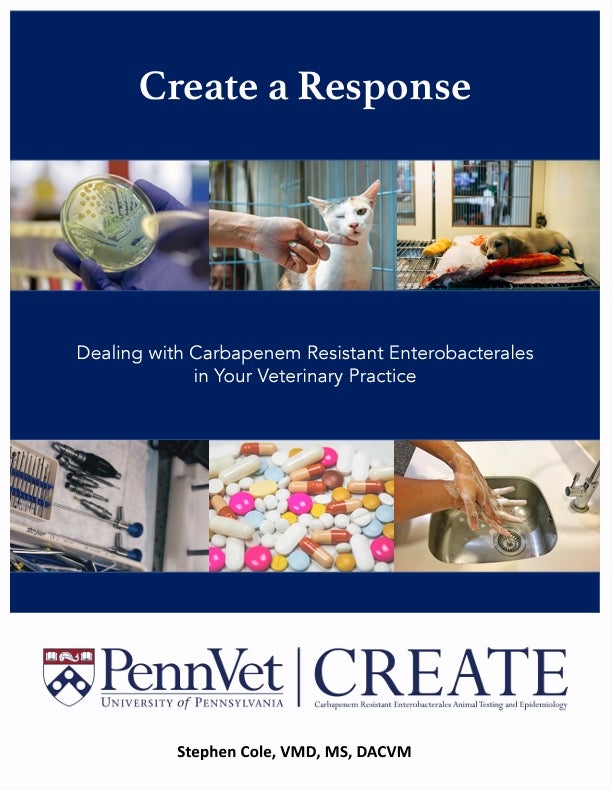CREATE a Plan and a Response
CREATE a Plan
CREATE a Plan provides guidance on proactive steps veterinary facilities can take before carbapenem-resistant Enterobacterales (CRE) are identified as a problem.
On this page, you will find some brief highlights, but for the most comprehensive information, please download our full-length document (PDF).

How to Recognize CRE
CRE are often first detected through routine culture and antimicrobial susceptibility testing (AST) of a suspected infection site (e.g., urine, wound).
Not all laboratories include a carbapenem in their standard panel so it may be necessary to request additional testing.
Culture and molecular testing approaches are available for detecting CRE.
Reporting CRE
When and who should report CRE to Public Health Officials can vary (and occasionally be confusing) from jurisdiction to jurisdiction.
Veterinary professionals in most jurisdictions have some sort of legal requirement to report unusual clusters of disease or pathogens high consequence.
Public Health reporting should be viewed as a positive step for developing a collaborative response.
Funding a Response
Costs associated with a veterinary CRE outbreak may be significant depending on how long it has gone on and how many animals are affected.
Identifying funds that can be used immediately to respond to CRE is an important preparation step.
Flagging Systems
Identifying suspect or known CRE patients immediately upon presentation to your hospital is a critical first step.
Infection Control
Policies for hand hygiene, personal protective equipment (PPE), housing, and environmental management can be developed prior to CRE outbreaks.
Training and assessment on these policies is critical for success.
Responsible Antibiotic Use
The judicious use of antimicrobials is an important component in the battle against CRE but should not be the only strategy used for prevention.
Even veterinary facilities that do not routinely use carbapenems are vulnerable to CRE introduction and spread because CRE are typically resistant to most antimicrobials.
Identifying a CRE Response Team
Should include internal stakeholders from all relevant hospital teams (i.e., clinicians, nursing, environmental management).
Also include internal liaisons to or representatives from your CRE testing laboratory and your public health department.
Identify a single individual with the authority to make time-sensitive decisions.
CREATE a Response
CREATE a Response offers strategies and protocols to implement after CRE has been detected or is suspected within a veterinary facility.
On this page, you will find some brief highlights, but for the most comprehensive information, please download our full-length document (PDF).

Animal Isolation
Animals with suspected or confirmed CRE should be isolated from general patient populations immediately.
CRE-positive patients should not be allowed to defecate in shared areas.
Employees that handle CRE positive patients should be highly aware of isolation protocols.
Laboratory Confirmation
Clinicians should work with their diagnostic laboratory to ensure that phenotypic and/or genotypic confirmation of CRE isolates is performed.
CREATE Reference Lab at Penn Vet can do this if your laboratory is not equipped, able, or willing.
Public Health and Human Contact Notification
Depending on the jurisdiction and reporting requirements, a diagnostic laboratory may or may not report the isolation of CRE to public health officials.
Currently the risk of transmission of CRE from animals to people is not well understood.
Veterinary staff, owners, and any other individual that has interacted with a CRE positive animal has a right to know about the exposure.
Enhance Infection Prevention
A veterinary facility should always have a strong infection prevention program in place, but a case of CRE in the facility should trigger additional messaging to staff.
Improve hand hygiene, PPE use, and environmental cleaning and disinfection.
Identify if There is Ongoing Transmission
Strategies such as contact tracing and point prevalence surveys can be used to evaluate if active spread is occurring within the facility.
Testing for subclinical carriage can be performed through the CREATE reference lab.
Environmental Management and Reservoirs
Affected spaces should be cleared of patients and “terminally cleaned.”
CRE are easily killed with most commercial disinfectants provided the manufacturer’s instructions for use (MIFU) are followed.
Targeted surveillance of CRE has proven valuable in our facility to help identify both sources and issues with infection control strategies. The CREATE Reference Lab offers environmental screening cultures “at cost.”
CREATE
Carbapenem Resistant Enterobacterales Animal Testing and Epidemiology
Phone: (215) 573-7425
Email: CREATE@vet.upenn.edu
